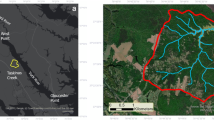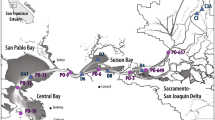Abstract
Concentrations of dissolved and particulate organic carbon (DOC and POC), total suspended solids (TSS), were measured daily, and phytoplankton pigments (chlorophyll-a and pheopigments) were measured every 3 days at three strategic stations along the eutrophic Loire River between November 2011 and November 2013 marked by a high annual and seasonal variability in hydrological regimes. This unique high-frequency dataset allowed to determine the POC origin (autochthonous or allochthonous). Some strong relationships were evidenced between POC, total pigments and TSS and were tested on a long-term database with a lower frequency (monthly data) to reconstitute unmeasured algal and detrital POC concentrations and estimate annual total organic carbon (TOC) fluxes from 1980 onwards. The results were subjected to only ≈25 % uncertainty and showed that the annual TOC fluxes at the outlet of the Loire River decreased from 520 103 tC year−1 (i.e. 4.7 t km−2 year−1) in the early 1990s to 150 103 tC year−1 (i.e. 1.4 t km−2 year−1) in 2012. Although DOC always dominates, the autochthonous POC represented 35 % of the TOC load at the basin outlet by the end of the 1980s and declined to finally represent 15 % only of the TOC. The control of phosphorus direct inputs and the invasion by Corbicula clams spp. which both occurred since the early 1990s probably highly reduced the development of phytoplankton. Consequently, the autochthonous POC contribution declined and TSS concentrations in summertime significantly decreased as well as a result of both less phytoplankton and less calcite precipitation. At the present time, at least 75 % of the POC has allochthonous origins in the upper Middle Loire but downstream, autochthonous POC dominates during summer phytoplanktonic blooms when total pigments concentrations reach up to 70 μg L−1 (equivalent to 75 % of the total POC).









Similar content being viewed by others
References
Abonyi A. (2014). Phytoplankton functional group composition along the River Loire (France), Ph.D. thesis . Hungary: University of Pannonia, Department of Limnology.
Abril, G., Nogueira, M., Etcheber, H., et al. (2002). Behaviour of organic carbon in nine contrasting European estuaries. Estuarine, Coastal and Shelf Science, 54, 241–262. doi:10.1006/ecss.2001.0844.
Amann, T., Weiss, A., & Hartmann, J. (2012). Carbon dynamics in the freshwater part of the Elbe estuary, Germany: Implications of improving water quality. Estuarine, Coastal and Shelf Science, 107, 112–121. doi:10.1016/j.ecss.2012.05.012.
Arheimer, B., Andréasson, J., Fogelberg, S., et al. (2005). Climate change impact on water quality: model results from southern Sweden. Ambio, 34, 559–566.
Barlocher, F., Seena, S., Wilson, K. P., & Williams, D. D. (2008). Raised water temperature lowers diversity of hyporheic aquatic hyphomycetes. Freshwater Biology, 53, 368–379. doi:10.1111/j.1365-2427.2007.01899.x.
Battin, T. J., Kaplan, L. A., Findlay, S., et al. (2009). Biophysical controls on organic carbon fluxes in fluvial networks. Nature Geoscience, 2, 595–595. doi:10.1038/ngeo602.
Billen, G., Cauwet, G., Dessery, S., et al. (1986). Origines et comportement du carbone organique dans l’estuaire de la Loire. Rapp P-v Réun Cons int Explor Mer, 186, 375–391.
Bouraoui, F., & Grizzetti, B. (2011). Long term change of nutrient concentrations of rivers discharging in European seas. The Science of the Total Environment, 409, 4899–916. doi:10.1016/j.scitotenv.2011.08.015.
Brancotte, V., & Vincent, T. (2002). L’invasion du réseau hydrographique français par les mollusques Corbicula Spp. Modalité de colonisation et rôle prépondérant des canaux de navigation. Bulletin Francais de la Peche et de la Pisciculture, 365(366), 325–337.
Bustillo, V., Moatar, F., Ducharne, A., et al. (2014). A multimodel comparison for assessing water temperatures under changing climate conditions via the equilibrium temperature concept: Case study of the Middle Loire River, France. Hydrological Processes, 28, 1507–1524. doi:10.1002/hyp.9683.
Carignan, R., & Kalff, J. (1980). Phosphorus sources for aquatic weeds: water or sediments? Science, 207, 987–989. doi:10.1126/science.207.4434.987.
Coynel, A., Etcheber, H., Abril, G., et al. (2005a). Contribution of small mountainous rivers to particulate organic carbon input in the Bay of Biscay. Biogeochemistry, 74, 151–171. doi:10.1007/s10533-004-3362-1.
Coynel, A., Seyler, P., Etcheber, H., et al. (2005b). Spatial and seasonal dynamics of total suspended sediment and organic carbon species in the Congo River. Global Biogeochemical Cycles, 19, 1–17. doi:10.1029/2004GB002335.
Dessery S., Dulac C., Laurenceau J. M., Meybeck M. (1984). Evolution du carbone organique «algal» et «détritique» dans trois rivières du bassin parisien. Arch Hydrobiol, 235–260.
Etcheber, H., Taillez, A., Abril, G., et al. (2007). Particulate organic carbon in the estuarine turbidity maxima of the Gironde, Loire and Seine estuaries: origin and lability. Hydrobiologia, 588, 245–259. doi:10.1007/s10750-007-0667-9.
floury, m., delattre, c., ormerod, s., & souchon, y. (2012). Global versus local change effects on a large european river. the science of the total environment, 441, 220–229. doi:10.1016/j.scitotenv.2012.09.051.
Gao, Q., Tao, Z., Shen, C., et al. (2002). Riverine organic carbon in the Xijiang River (South China): Seasonal variation in content and flux budget. Environmental Geology, 41, 826–832. doi:10.1007/s00254-001-0460-4.
Grimvall, A., Von Brömssen, C., & Lindström, G. (2014). Using process-based models to filter out natural variability in observed concentrations of nitrogen and phosphorus in river water. Environmental Monitoring and Assessment, 186, 5135–5152. doi:10.1007/s10661-014-3765-y.
Grosbois, C., Négrel, P., Grimaud, D., & Fouillac, C. (2001). An overview of dissolved and suspended matter fluxes in the Loire River Basin: natural and anthropogenic inputs. Aquat Geochemistry, 7, 81–105.
Grosbois, C., Meybeck, M., Lestel, L., et al. (2012). Severe and contrasted polymetallic contamination patterns (1900–2009) in the Loire River sediments (France). The Science of the Total Environment, 435–436, 290–305. doi:10.1016/j.scitotenv.2012.06.056.
Halliday, S. J., Wade, A. J., Skeffington, R. A., et al. (2012). An analysis of long-term trends, seasonality and short-term dynamics in water quality data from Plynlimon, Wales. The Science of the Total Environment, 434, 186–200. doi:10.1016/j.scitotenv.2011.10.052.
Hardenbicker, P., Rolinski, S., Weitere, M., & Fischer, H. (2014). Contrasting long-term trends and shifts in phytoplankton dynamics in two large rivers. International Review of Hydrobiology, 99, 326–334. doi:10.1002/iroh.201301680.
Hein, T., Baranyi, C., Herndl, G. J., et al. (2003). Allochthonous and autochthonous particulate organic matter in floodplains of the River Danube : the importance of hydrological connectivity. Freshwater Biology, 48, 220–232.
Hood J. (2012). The role of submersed macrophytes in river eutrophication and biogeochemical nutrient cycling, Ph.D. thesis. Canada: University of Waterloo.
Hope, D., Billett, M. F., & Cresser, M. S. (1994). A review of the export of carbon in river water: fluxes and processes. Environmental Pollution, 84, 301–324.
Howden, N. J. K., Burt, T. P., Worrall, F., et al. (2010). Nitrate concentrations and fluxes in the River Thames over 140 years (1868–2008): are increases irreversible? Hydrological Processes, 24, 2657–2662. doi:10.1002/hyp.7835.
Istvánovics, V., & Honti, M. (2012). Efficiency of nutrient management in controlling eutrophication of running waters in the Middle Danube Basin. Hydrobiologia, 686, 55–71.
Istvánovics, V., Honti, M., Kovács, Á., et al. (2014). Phytoplankton growth in relation to network topology: time-averaged catchment-scale modelling in a large lowland river. Freshwater Biology, 59, 1856–1871. doi:10.1111/fwb.12388.
Latapie, A., Camenen, B., Rodrigues, S., et al. (2014). Assessing channel response of a long river influenced by human disturbance. CATENA, 121, 1–12. doi:10.1016/j.catena.2014.04.017.
Lehmann, A., & Rode, M. (2001). Long-term behaviour and cross-correlation water quality analysis of the River Elbe, Germany. Water Research, 35, 2153–60.
Ludwig, W., & Probst, J. L. (1996). Predicing the oceanic input of organic carbon by continental erosion. Global Biogeochemical Cycles, 10, 23–41.
Lund, J. W. G., & Talling, J. F. (1957). Botanical limnological methods with special reference to the algae. Botanical Review, 23, 489–583. doi:10.1007/BF02870144.
Meybeck, M. (2005). Origins and behaviours of carbon species in world rivers. In E. Roose, R. Lal, C. Feller, et al. (Eds.), Erosion and Carbon dynamics (pp. 209–238). Boca R: CRC.
Meybeck, M., Cauwet, G., Dessery, S., et al. (1988). Nutrients (organic C, P, N, Si) in the eutrophic River Loire (France) and its estuary. Estuarine, Coastal and Shelf Science, 27, 595–624.
Minaudo, C., Meybeck, M., Moatar, F., et al. (2015). Eutrophication mitigation in rivers: 30 years of trends in spatial and seasonal patterns of biogeochemistry of the Loire River (1980–2012). Biogeosciences, 12, 2549–2563. doi:10.5194/bg-12-2549-2015.
Moatar, F., & Gailhard, J. (2006). Water temperature behaviour in the River Loire since 1976 and 1881. Comptes Rendus Geosci, 338, 319–328. doi:10.1016/j.crte.2006.02.011.
Moatar, F., Person, G., Meybeck, M., et al. (2006). The influence of contrasting suspended particulate matter transport regimes on the bias and precision of flux estimates. The Science of the Total Environment, 370, 515–531. doi:10.1016/j.scitotenv.2006.07.029.
Moatar, F., Meybeck, M., Raymond, S., et al. (2013). River flux uncertainties predicted by hydrological variability and riverine material behaviour. Hydrological Processes, 27, 3535–3546. doi:10.1002/hyp.9464.
Neal, C. (2001). The potential for phosphorus pollution remediation by calcite precipitation in UK freshwaters. Hydrology and Earth System Sciences, 5, 119–131. doi:10.5194/hess-5-119-2001.
Némery, J., Mano, V., Coynel, A., et al. (2013). Carbon and suspended sediment transport in an impounded alpine river (Isère, France). Hydrological Processes, 27, 2498–2508. doi:10.1002/hyp.9387.
Oudin, L. C., Lair, N., Leitão, M., et al. (2009). Rivers of Europe (Eds Tockner K. & C.T. Robinson). London: British Library.
Pigneur, L.-M., Falisse, E., Roland, K., et al. (2014). Impact of invasive Asian clams, Corbicula spp., on a large river ecosystem. Freshwater Biology, 59, 573–583. doi:10.1111/fwb.12286.
Raymond, S., Moatar, F., Meybeck, M., & Bustillo, V. (2013). Choosing methods for estimating dissolved and particulate riverine fluxes from monthly sampling. Hydrological Sciences Journal, 58, 1326–1339. doi:10.1080/02626667.2013.814915.
Reynolds, C. S., & Descy, J.-P. (1996). The production, biomass and structure of phytoplankton in large rivers. Archiv für Hydrobiologie, Supplement, 113, 161–187.
Rott, E. (1981). Some results from phytoplankton counting intercalibrations. Schweizerische Zeitschrift für Hydrologie, 43, 34–62. doi:10.1007/BF02502471.
Schnebelen, N., Couturier, A., Bourennane, H., et al. (2002). Impacts of alternative agricultural practices on the reduction of nitric pollution in the Beauce limestone aquifer (France) (17th WCSS, p. 1229–1–1229–8).
Slaets, J. I. F., Schmitter, P., Hilger, T., et al. (2014). A turbidity-based method to continuously monitor sediment, carbon and nitrogen flows in mountainous watersheds. Journal of Hydrology, 513, 45–57. doi:10.1016/j.jhydrol.2014.03.034.
Utermöhl, H. (1958). Zur Vervollkommnung der quantitativen Phytoplankton-Methodik. Mitteilungen Internationale Vereinigung fur Theoretische und Angewandte Limnologie, 9, 1–38.
Verity, P. G. (2002). A Decade of Change in the Skidaway River Estuary. II. Particulate Organic Carbon, Nitrogen, and Chlorophyll-a. Estuaries, 25, 961–975.
Vohmann, A., Borcherding, J., Kureck, A., et al. (2010). Strong body mass decrease of the invasive clam Corbicula fluminea during summer. Biological Invasions, 12, 53–64. doi:10.1007/s10530-009-9429-0.
Wang, X.-C., Chen, R. F., & Gardner, G. B. (2004). Sources and transport of dissolved and particulate organic carbon in the Mississippi River estuary and adjacent coastal waters of the northern Gulf of Mexico. Marine Chemistry, 89, 241–256. doi:10.1016/j.marchem.2004.02.014.
Wetzel, R. G. (1984). Detrital dissolved and particulate organic carbon functions in aquatic ecosystems. Bulletin of Marine Science, 35, 503–509.
Whitehead, P. G., Wilby, R., Battarbee, R., et al. (2009). A review of the potential impacts of climate change on surface water quality. Hydrological Sciences Journal, 54, 101–123. doi:10.1623/hysj.54.1.101.
Wysocki, L. A., Bianchi, T. S., Powell, R. T., & Reuss, N. (2006). Spatial variability in the coupling of organic carbon, nutrients, and phytoplankton pigments in surface waters and sediments of the Mississippi River plume. Estuarine, Coastal and Shelf Science, 69, 47–63. doi:10.1016/j.ecss.2006.03.022.
Acknowledgments
Data used in this study was funded by the French electricity company “Electricité de France”, “l’Etablissement Public Loire”, FEDER European funds and by the Loire River Basin Agency (AELB). This study would not have been possible without the great efforts made by the different persons who sampled the Loire every day (Yannick Bennet, André Dubois, Hervé Couet, Laurence Lanctin, Didier Louvel), and those who made the countless analysis (Laureline Gorse, Eric Imbert, Andras Abonyi, Anne-Marie Lançon and Maria Leitao).
Author information
Authors and Affiliations
Corresponding author
Rights and permissions
About this article
Cite this article
Minaudo, C., Moatar, F., Coynel, A. et al. Using recent high-frequency surveys to reconstitute 35 years of organic carbon variations in a eutrophic lowland river. Environ Monit Assess 188, 41 (2016). https://doi.org/10.1007/s10661-015-5054-9
Received:
Accepted:
Published:
DOI: https://doi.org/10.1007/s10661-015-5054-9




